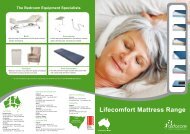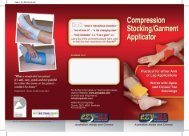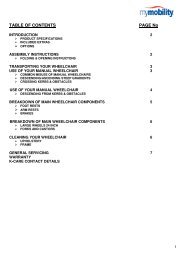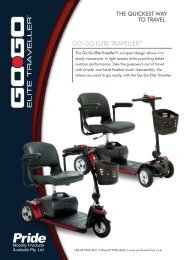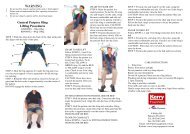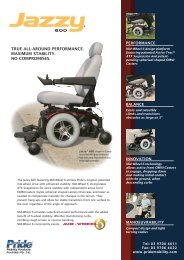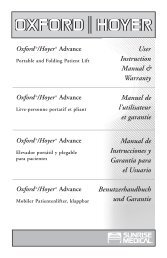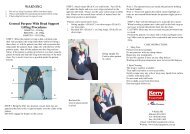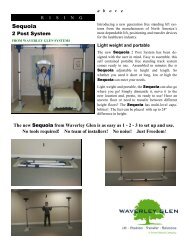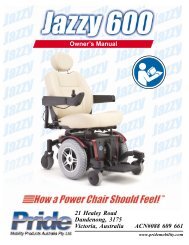QUANTUM R-4000 - Pride Mobility Products
QUANTUM R-4000 - Pride Mobility Products
QUANTUM R-4000 - Pride Mobility Products
You also want an ePaper? Increase the reach of your titles
YUMPU automatically turns print PDFs into web optimized ePapers that Google loves.
II. SAFETY<br />
To navigate down a kerb or stationary obstacle:<br />
1. Approach the kerb or obstacle slowly, and make sure the power chair is traveling perpendicular to the obstacle. See<br />
figure 2.<br />
2. Reduce the forward speed just before the front wheels come in contact with the obstacle.<br />
3. Increase the forward speed only after the rear wheels have cleared the obstacle and you are once again on a level surface.<br />
WARNING! Do not attempt to have your power chair climb or descend an obstacle that is higher<br />
than 5 cm unless you have the assistance of an attendant.<br />
WARNING! Do not attempt to have your power chair proceed rearward down any step, kerb, or<br />
other obstacle. This may cause the power chair to tip.<br />
Stairs and Escalators<br />
Power chairs are not designed to travel up or down stairs or escalators. Always use a lift.<br />
WARNING! Never use your power chair to negotiate steps or escalators.<br />
Doors<br />
! Determine if the door opens toward or away from you.<br />
! Drive your power chair gently and slowly forward to push the door open. Or drive your power chair gently and slowly<br />
rearward to pull the door open.<br />
Lifts<br />
Modern lifts have a door edge safety mechanism that, when pushed, reopens the lift door(s).<br />
! If you are in the doorway of a lift when the door(s) begin to close, push on the rubber door edge or allow the rubber<br />
door edge to contact the power chair and the door will reopen.<br />
! Use care that handbags, packages, or power chair accessories do not become caught in lift doors.<br />
Lifts/Elevation <strong>Products</strong><br />
If you will be traveling with your power chair, you may find it necessary to use a lift/elevation product to aid in transportation.<br />
<strong>Pride</strong> recommends that you closely review the instructions, specifications, and safety information set forth by the<br />
manufacturer of the lift/elevation product before using that product.<br />
WARNING! Never sit on your power chair when it is being used in connection with any<br />
type of lift/elevation product. Your power chair was not designed with such use in mind<br />
and any damage or injury incurred from such use is not the responsibility of <strong>Pride</strong>.<br />
Motor Vehicle Transport<br />
<strong>Pride</strong> recommends that you do not remain seated in your power chair while traveling in a motor vehicle. The power chair<br />
should be stowed in the boot of a car or in the back of a truck or van with batteries removed and properly secured. In<br />
addition, all removable power chair parts, including the armrests, seat, front riggings, controller, and shrouds should be<br />
removed and/or properly secured during motor vehicle transport.<br />
WARNING! Do not sit on your power chair while it is in a moving vehicle.<br />
WARNING! Always be sure your power chair and its batteries are properly secured when it is being<br />
transported. Batteries should be secured in an upright position and protective caps should be installed<br />
on the battery terminals. Batteries should not be transported with any flammable or combustible items.<br />
Positioning Belts<br />
Your Quantum Rehab Provider, therapist(s), and other healthcare professionals are responsible for determining your requirement<br />
for a positioning belt in order to operate your power chair safely.<br />
14 www.pridemobility.com Quantum R-<strong>4000</strong> Series



